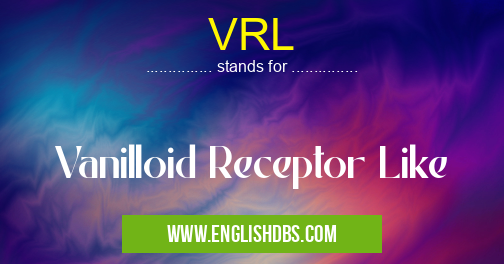What does VRL mean in UNCLASSIFIED
VRL stands for Vanilloid Receptor Like, which are a group of ion channels that belong to the transient receptor potential (TRP) superfamily. These channels are activated by a variety of stimuli, including heat, cold, and certain chemicals. VRLs play an important role in sensory perception, inflammation, and pain.

VRL meaning in Unclassified in Miscellaneous
VRL mostly used in an acronym Unclassified in Category Miscellaneous that means Vanilloid Receptor Like
Shorthand: VRL,
Full Form: Vanilloid Receptor Like
For more information of "Vanilloid Receptor Like", see the section below.
Key Features of VRLs
- Ion channels: VRLs are ion channels that allow the flow of ions across cell membranes.
- Transient receptor potential (TRP) superfamily: VRLs belong to the TRP superfamily of ion channels.
- Activation by heat, cold, and chemicals: VRLs can be activated by a variety of stimuli, including heat, cold, and certain chemicals.
- Role in sensory perception, inflammation, and pain: VRLs play an important role in sensory perception, inflammation, and pain.
Subtypes of VRLs
There are three main subtypes of VRLs:
- TRPV1: This subtype is activated by heat and acidic conditions. It is responsible for the sensation of pain and inflammation.
- TRPV2: This subtype is activated by heat and noxious chemicals. It is involved in pain and inflammation.
- TRPV3: This subtype is activated by warm temperatures. It is involved in the sensation of warmth and pain.
Essential Questions and Answers on Vanilloid Receptor Like in "MISCELLANEOUS»UNFILED"
What is VRL (Vanilloid Receptor Like)?
VRL is a family of ion channels expressed in various tissues throughout the body. VRLs are activated by a variety of stimuli, including heat, cold, and certain chemicals. They play a role in pain sensation, temperature regulation, and inflammation.
How many VRL subtypes are there?
There are three VRL subtypes: VRL-1, VRL-2, and VRL-3. VRL-1 is the most widely expressed subtype and is responsible for mediating responses to heat and pain. VRL-2 and VRL-3 are less well-characterized, but they have been implicated in cold sensation and inflammation.
What is the role of VRLs in pain sensation?
VRL-1 is activated by noxious heat and acidic pH, which are both associated with tissue damage. When VRL-1 is activated, it sends a signal to the spinal cord and brain, which results in the perception of pain.
Can VRLs be targeted for pain relief?
Yes, VRLs are a potential target for the development of new pain medications. Several drugs that target VRL-1 have been developed, and some of these drugs have shown promise in clinical trials.
Are VRLs involved in any other physiological processes?
In addition to their role in pain sensation, VRLs are also involved in temperature regulation, inflammation, and gastrointestinal motility. VRL-3, in particular, has been shown to play a role in the regulation of body temperature.
Final Words: VRLs are a group of ion channels that play an important role in sensory perception, inflammation, and pain. Understanding the function of VRLs could lead to the development of new therapies for pain and inflammation.
VRL also stands for: |
|
| All stands for VRL |
